
2023 Neutrals Research & Selection Trends
A contemporary analysis of the most significant procedures, sources, and trends in neutral (arbitrator and mediator) research and selection.
Download Full PDFIntroduction
Alternative Dispute Resolution employment is expected to grow 5% from 2022 to 2032, surpassing the average for all other occupations. Yet, the mystery surrounding effective neutral research and selection practices persists. In order to learn more about the growth areas and opportunities for neutral (arbitrator and mediator) research and selection, Courtroom Insight conducted a survey targeted at diverse roles across neutral research and selection experiences. After analyzing survey results, Courtroom Insight elicited a contemporary understanding of the significant procedures, sources, and trends within neutral research and selection.
Index
- What type of neutrals were utilized most in 2023?
- How are neutrals researched for a particular case?
- How important are various sources of information when evaluating a potential neutral?
- Are external data sources considered when evaluating a neutral?
- What are the most popular external data sources for information on neutrals?
- Are clients willing to pay for neutral research?
- How is the cost of research justified to clients?
- What are the biggest obstacles to locating and retaining the right neutral for a case?
- How often do clients propose neutrals?
- How are newer neutrals considered in the selection process?
- What factors help determine the effectiveness of a mediator?
- What factors help determine the effectiveness of an arbitrator?
- At the conclusion of a case, what actions are taken with the research materials gathered on neutrals?
- How often are researchers surprised by a neutral?
- Why are researchers surprised by neutrals?
Methods
A. Procedure
The survey was conducted online through Survey Monkey's platform, and respondents' personal identities remained anonymous. Respondents were prompted to respond to a set of 16 questions regarding neutral (arbitrator and mediator) research methods, selection preferences, obstacles faced, and other relevant factors. The questions were designed to gather information about the respondents' experiences with neutral research and their opinions about the current state of the field. The survey was open to all legal professionals with experience in neutral research, and participation was voluntary.
B. Participants
In total, 1,045 participants responded to the survey. The participants belonged to diverse roles with respect to neutral research and selection. Notably, most of the respondents were responsible for making mediator/arbitrator recommendations at their workplace. Employer types were evenly represented, with corporation/in-house being the most common (21.6%), followed closely by medium-sized law firms (50-199 lawyers) (18.5%), small law firms (2-49 lawyers) (16.6%), and large law firms (200+ lawyers) (16.5%). The majority of respondents reported working primarily for defense (62.52%), whereas the minority of respondents primarily represented plaintiffs (16.08%). Only 21.39% of respondents reported evenly representing both sides. Geographically, the Midwest (US) had the highest representation at 26.4%, followed by the Northeast (US) at 24.8%, the West (US) at 19.1%, and the South (US) at 14.0%. Furthermore, participants from Canada, the United Kingdom, and other international locations collectively constituted 8.1% of the survey sample. These findings underline the comprehensive cross-section of professionals from different employer types, practice areas, and global regions.
C. Data Analysis
The data collected from the survey were analyzed using descriptive statistics. The results were tabulated and presented using tables and charts to facilitate interpretation. The analysis focused on identifying patterns and trends in the responses to the survey questions, as well as exploring the relationships between different variables.
Results
A. What type of neutrals were utilized most in 2023?
The most frequently selected neutral was Mediator (32.2%), followed by Discovery Master (25.7%), and Early Neutral Evaluator (23.6%).
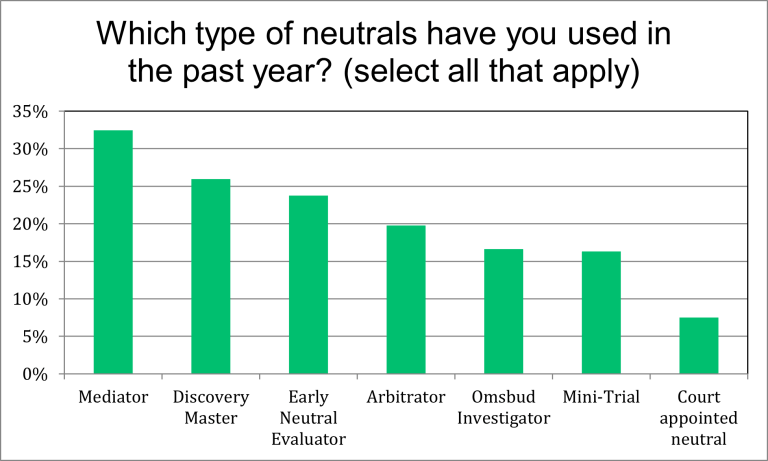
B. How are neutrals researched for a particular case?
The top two approaches for researching neutrals were consulting an internal database (29.2%) and/or performing an internet search (28.2%). This indicates a reliance on digital resources for identifying and evaluating neutrals.

C. How important are various sources of information when evaluating a potential neutral?
The average rankings assigned to different sources of information reveal that professional work history was considered the most important information (3.2), followed by internal or external recommendations (3.04) and the neutral's effectiveness/ability to reach closure (3.03).
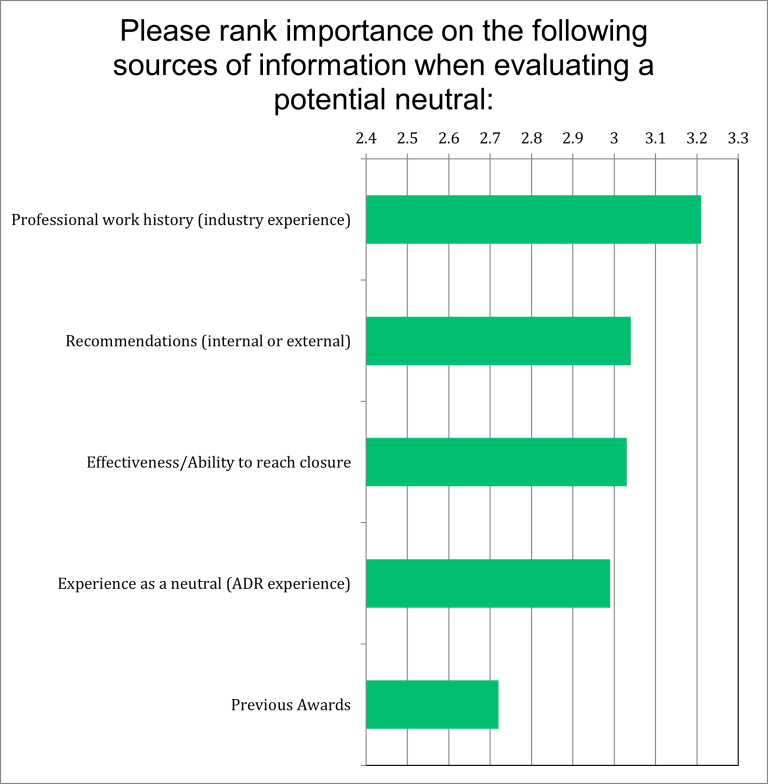
D. Are external data sources considered when evaluating a neutral?
The majority (96.3%) of respondents reported using external data sources to obtain information about neutrals. This demonstrates the importance of leveraging external insights and information when evaluating a neutral.

E. What are the most popular external data sources for information on neutrals?
The top three external data sources included, Arbitrator Intelligence (27.9%), Global Arbitration Review (25.4%), and AAA/JAMS (18.18%).
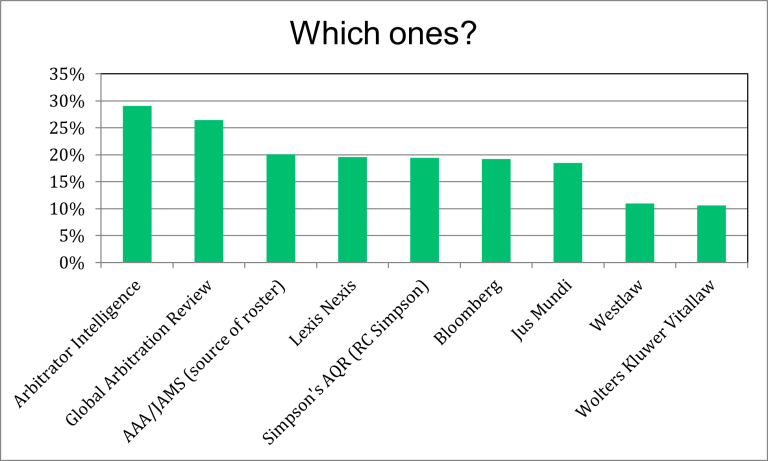
F. Are clients willing to pay for neutral research?
A substantial number of participants (63.2%) indicated that clients are willing to pay the total cost for neutral research. This suggests that clients place a high value on this aspect of case preparation.

G. How is the cost of research justified to clients?
Respondents primarily emphasized clear communication of research objectives and how those objectives are relevant to client needs and decision-making. Below were common responses that demonstrated these findings:
H. What are the biggest obstacles to locating and retaining the right neutral for a case?
Lack of information about a neutral/unfamiliarity (35.8%) and lack of agreement between parties (34%) were the top challenges identified in locating and retaining the right neutral for a case. This highlights the importance of information availability and consensus in the selection process.
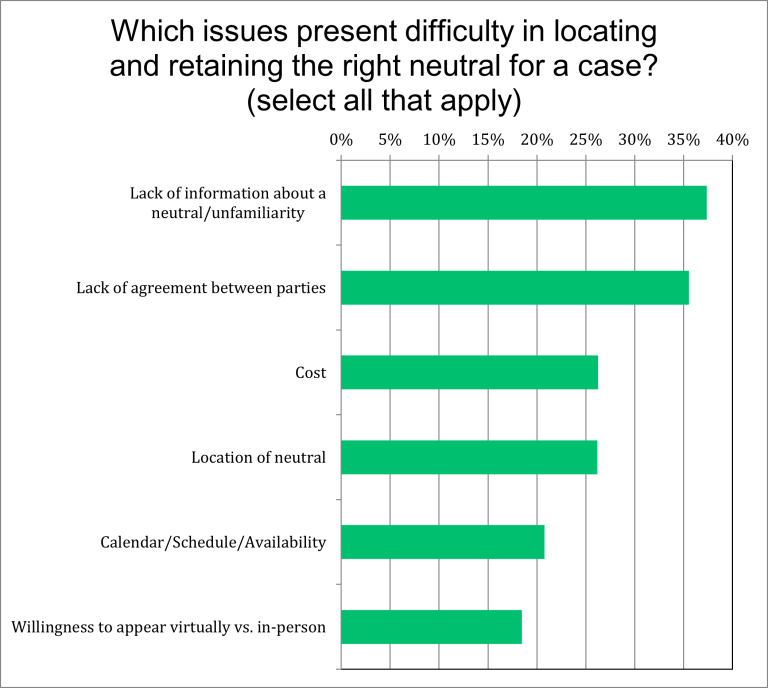
I. How often do clients propose neutrals?
The majority of respondents reported that clients usually (38.3%) or sometimes (30.9%) propose neutrals. This indicates active client involvement in the understanding of the value of neutrals and the selection process.
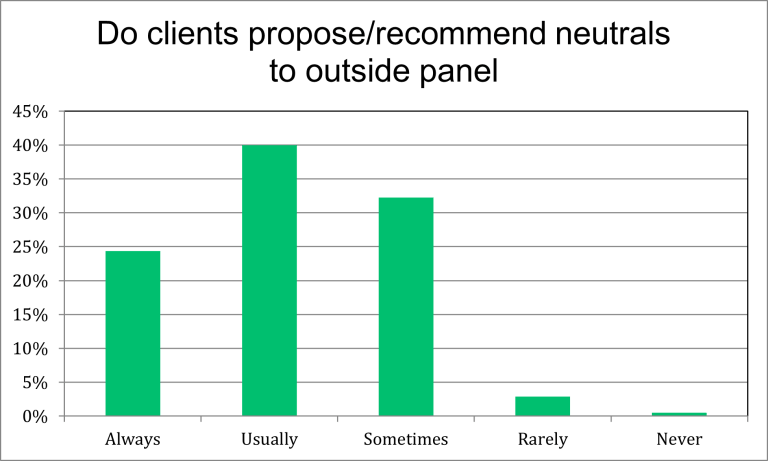
J. How are newer neutrals considered in the selection process?
A significant proportion (94.9%) of respondents were open to considering relatively new neutrals without an established track record. This may reflect a willingness to explore fresh talent in the field.
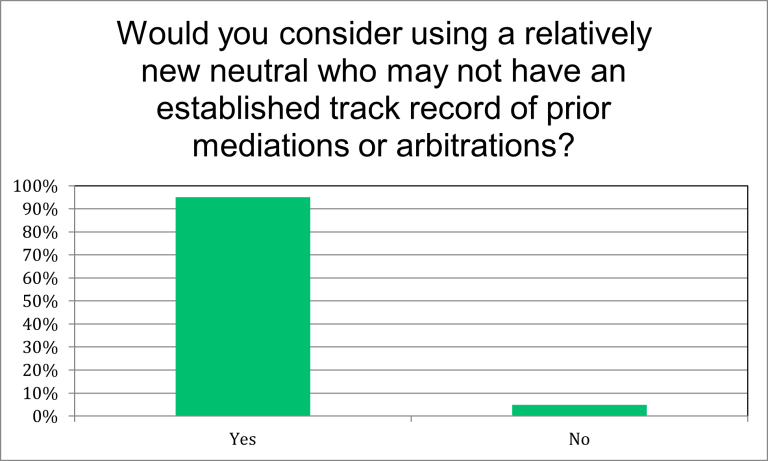
K. What factors help determine the effectiveness of a mediator?
On average, participants ranked legal ability/knowledge (3.48), integrity, objectivity, and impartiality (3.45), and oral and written communication skills (3.41) as the three most important factors. This highlights the significance of both legal expertise, ethical qualities, and communication skills for mediator selection.
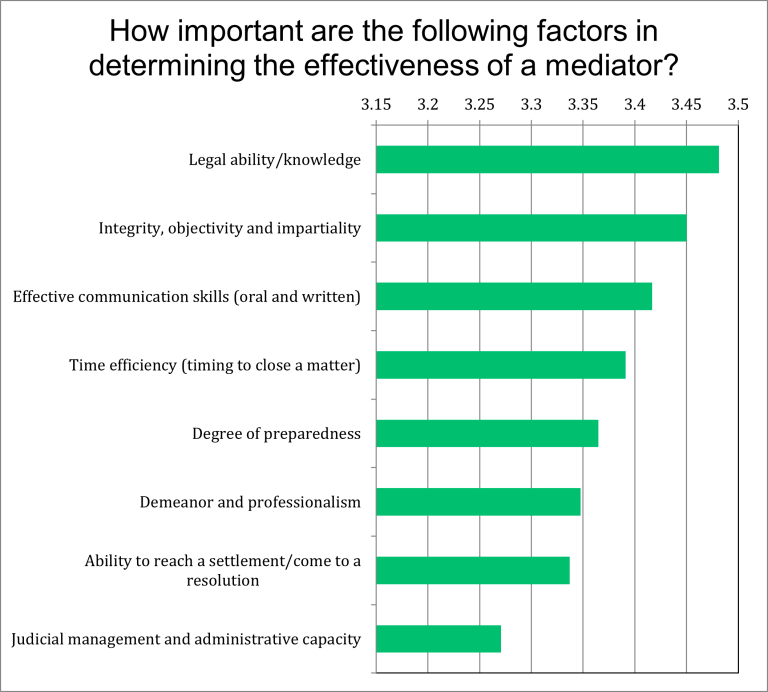
L. What factors help determine the effectiveness of an arbitrator?
On average, integrity, objectivity, and impartiality (3.49), legal ability/knowledge (3.42), and oral and written communication skills (3.42) were deemed the most important qualities. These findings underscore the more significant value placed on ethical integrity when it comes to arbitrator selection.
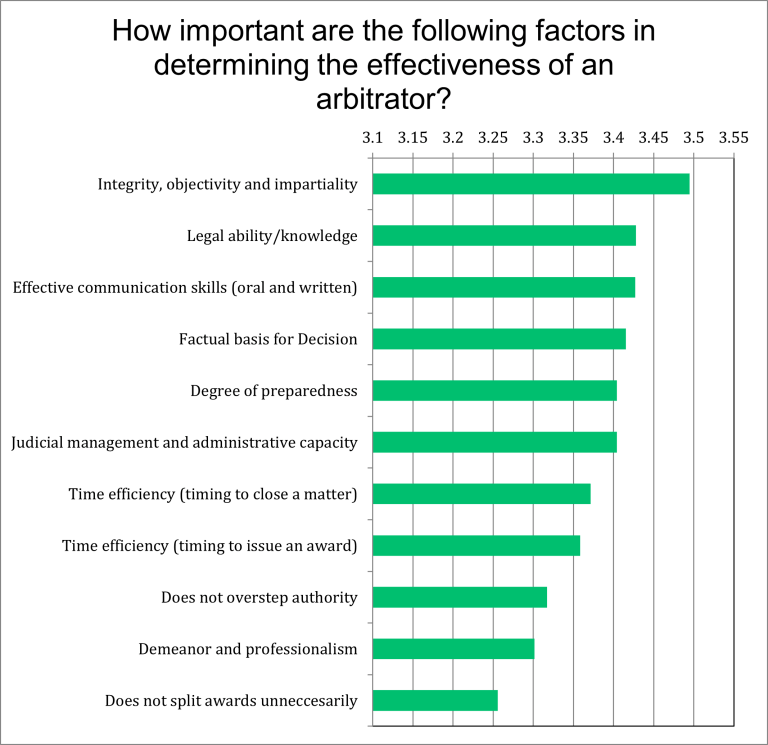
M. At the conclusion of a case, what actions are taken with the research materials gathered on neutrals?
Most respondents indicated that research materials were saved to personal hard drive (42.6%) or filed with the case (34.5%). While the third common approach was storing the information in an internal database (34.31%). This demonstrates that although most respondents lack a streamlined system for information sharing, these systems are beginning to rise in popularity.

N. How often are researchers surprised by a neutral?
The majority (90.2%) of respondents reported being surprised by a mediator or arbitrator.

O. Why are researchers surprised by neutrals?
The surprises were frequently related to the individuals' neutrality and impartiality, or their assessment of evidence. This may suggest a common experience of unexpected outcomes in the dispute resolution processes. Below were some common responses to the question, “How have you been surprised by a neutral?,” that demonstrated this:
Conclusion
The results of the survey uncovered valuable insights into the current state of neutral research and selection practices. The study emphasized the which factors are important in assessing neutrals, including their professional work history, work recommendations, and their ability to achieve closure. It also highlights the growing reliance on external data sources for gathering information about neutrals, indicating a need for supplementary resources in the selection process. Moreover, the willingness of clients to invest in neutral research underscores its perceived value in case preparation.
Through the survey, responders expressed challenges in finding and retaining the right neutral primarily revolve around information gaps and disputes among parties, reinforcing the importance of information accessibility and consensus. Legal professionals also shared a readiness to consider newer neutrals without a well-established track record, showcasing a willingness to explore emerging talent. The effectiveness of mediators and arbitrators hinges on factors like legal knowledge, ethical qualities, and communication skills, illustrating the multifaceted nature of these roles. Surprisingly, many respondents have encountered unexpected aspects of neutrals' behavior, particularly related to impartiality and evidence assessment, highlighting the nuances involved in selecting and assessing neutrals. These findings offer valuable guidance for legal professionals and organizations, enhancing their neutral research and selection processes to meet the growing demand for ADR services, ultimately elevating the quality and effectiveness of dispute resolution practices. Want to download our research survey results? Download below:
Recorded Webinar
Download Full PDF Survey Results
Contact Us
If you are looking for guidance or information on our products, please contact us.


Headquarters
2010 Crow Canyon Pl #100
San Ramon, CA 94583

